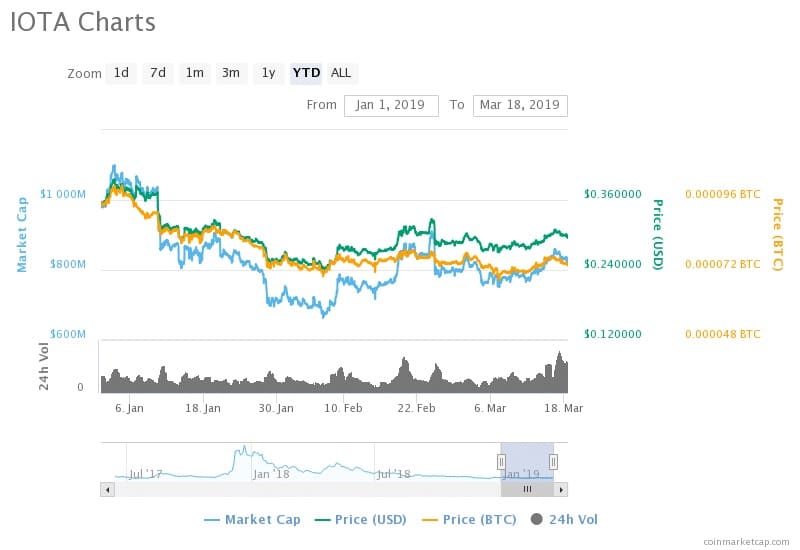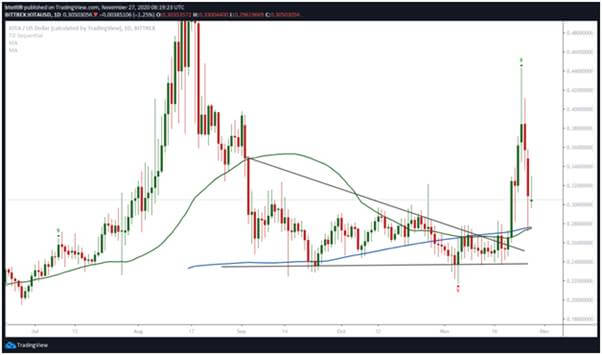

In 2018, the IOTA Foundation was chartered as a Stiftung in Berlin, with the goal to assist in the research and development, education and standardisation of IOTA technology. In 2017, early IOTA token investors donated 5% of the total token supply for continued development and to endow what became later became the IOTA Foundation. Approximately 1300 BTC were raised, corresponding to approximately US$500,000 at that time, and the total token supply was distributed pro-rata over the initial investors. Initial development was funded by an online public crowdsale, with the participants buying the IOTA value token with other digital currencies. The value transfer protocol IOTA, named after the smallest letter of the Greek alphabet, was created in 2015 by David Sønstebø, Dominik Schiener, Sergey Ivancheglo, and Serguei Popov.

#IOTA VALUE ALL TIME UPDATE#
A testnet for a follow-up update called Coordicide, or IOTA 2.0, was deployed in late 2020, with the aim of releasing a distributed network that no longer relies on the coordinator for consensus in 2021. In this update, controversial decisions such as ternary encoding and quantum proof cryptography were left behind and replaced with established standards. As a result, IOTA was rewritten from the ground up for a network update called Chrysalis, or IOTA 1.5, which launched on 28 April 2021. IOTA has been criticized due to its unusual design, of which it is unclear whether it will work in practice. As the coordinator is a single point of failure, the network is currently centralized. The network currently achieves consensus through a coordinator node, operated by the IOTA Foundation. Transactions can therefore be issued without fees, facilitating microtransactions. IOTA does not use miners to validate transactions, instead, nodes that issue a new transaction on the network must approve two previous transactions. It uses a directed acyclic graph to store transactions on its ledger, motivated by a potentially higher scalability over blockchain based distributed ledgers. IOTA is an open-source distributed ledger and cryptocurrency designed for the Internet of things (IoT). Archived from the original (PDF) on 14 August 2020. That being said, the average MIOTA price could anchor at $0.49.Open-source distributed ledger and cryptocurrency By the end of the month, MIOTA is likely to fall by $1.27%.Īccording to the current market situation, the price could be a maximum of $0.49 by 2025, and minimum price down to $0.46. During the mid of July, the price is expected to fall by a maximum of $115.30%. By the end of the month, MIOTA is likely to grow by $1.27%.īased on IOTA's price fluctuations, we predicted that the price of MIOTA would fall by -$10.22% at the beginning of July 2023. During the mid of July, the price is expected to rise by a maximum of $115.30%.

If we focus on overall growth, IOTA grew by 76.53773023759173% last month.įrom our last month's IOTA price prediction, we predicted that IOTA (MIOTA) would continue its bullish stance ahead.Īt the moment, IOTA is trading at $0.16, which could peak at $0.34 soon.īased on IOTA's price fluctuations, we have predicted that the price of MIOTA would grow by -$10.22% at the beginning of July 2023. Last month's average IOTA (MIOTA) price was $0.41, and as per our forecast, IOTA(MIOTA) traded as high as $0.56 and as low as 0.00 last month. However, we decided to make the best-projected value and estimated growth for IOTA's future. It is estimated that IOTA's value and growth will be astronomical because it is so powerful and has tremendous potential.Ĭompared to other asset classes, IOTA price is challenging to predict and sensitive to market conditions. Over the past few years, crypto has risen rapidly.


 0 kommentar(er)
0 kommentar(er)
